
HMS Leander was a 50-gun spar-decked frigate of the Royal Navy which saw service in the Napoleonic Wars, the War of 1812, and the Second Barbary War.
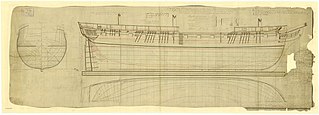
HMS Saldanha was a 36-gun fifth-rate Apollo-class frigate of the Royal Navy. She was commissioned in April 1810 and spent her entire career serving on the Irish Station, including capturing a fast-sailing French privateer on 11 October 1811. In the evening of 4 December that year Saldanha was serving off Lough Swilly when she was caught in a storm. Last seen sailing off Fanad Head, the ship was wrecked in a nearby bay with every person on board being killed and the only survivors being a parrot and a dog. The wreck was memorialised by Thomas Sheridan in his poem The Loss of the Saldanha.

HMS Apollo, the third ship of the Royal Navy to be named for the Greek god Apollo, was a 38-gun Artois-class fifth-rate frigate of the Royal Navy. She served during the French Revolutionary Wars, but her career ended after just four years in service when she was wrecked on the Haak sands off the Dutch coast.

The Cruizer class was an 18-gun class of brig-sloops of the Royal Navy. Brig-sloops were the same as ship-sloops except for their rigging. A ship-sloop was rigged with three masts whereas a brig-sloop was rigged as a brig with only a fore mast and a main mast.

HMS Active was a Royal Navy fifth-rate frigate launched on 14 December 1799 at Chatham Dockyard. Sir John Henslow designed her as an improvement on the Artois-class frigates. She served during the French Revolutionary Wars and the Napoleonic Wars, capturing numerous enemy vessels. Her crews participated in one campaign and three actions that would later qualify them for the Naval General Service Medal. She returned to service after the wars and finally was broken up in 1860.
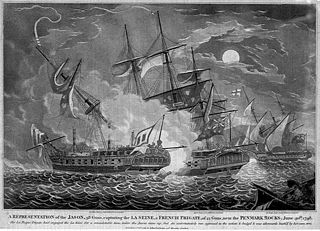
Seine was a 38-gun French Seine-class frigate that the Royal Navy captured in 1798 and commissioned as the fifth-rate HMS Seine. On 20 August 1800, Seine captured the French ship Vengeance in a single ship action that would win for her crew the Naval General Service Medal. Seine's career ended in 1803 when she hit a sandbank near the Texel.
HMS Newcastle was a 50-gun fourth rate of the Royal Navy which saw service in the Napoleonic Wars and the War of 1812.

HMS Grasshopper was a Cruizer-class brig-sloop of the Royal Navy. She was launched in 1806, captured several vessels, and took part in two notable actions before the Dutch captured her in 1811. She then served The Netherlands navy until she was broken up in 1822.

HMS Aigle was a 36-gun, fifth-rate frigate of the Royal Navy. Ordered on 15 September 1799 and built at Bucklers Hard shipyard, she was launched 23 September 1801. More than fifty of her crew were involved in the Easton Massacre when she visited Portland in April 1803 to press recruits. Her captain and three other officers stood trial for murder but were acquitted. Much of Aigle's career as a frigate was spent trying to keep the English Channel free of enemy warships and merchant vessels. On 22 March 1808, she was first into the action against two large French frigates, compelling one to seek the shelter of the Île de Groix batteries and forcing the other onto the shore.
The Maidstone-class frigate was a 32-gun fifth-rate frigate class of two ships designed by Sir John Henslow and ordered on 4 February 1795. The class was a close copy of Henslow's earlier Alcmene class, but was constructed of pitch pine instead of oak. With concerns over whether the lighter building material would safely hold an armament of 18-pounder long guns, the class was instead armed with smaller 12-pounders. Both ships of the class served through the French Revolutionary Wars, but neither had a long career. Shannon was sold at Sheerness Dockyard in May 1802 and Maidstone was placed in ordinary at Chatham Dockyard in 1804 before being broken up in 1810.
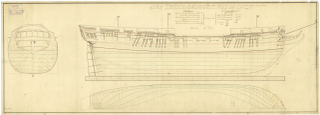
The Thames-class frigate was a 32-gun fifth-rate frigate class of eight ships of the Royal Navy based on the Richmond-class frigate designed by William Bately. The ships were ordered to the older design, which was of a smaller type of ship compared to more modern designs, so that they could be built quickly and cheaply in time to assist in defending against Napoleon's expected invasion of Britain. The class received several design changes to the Richmond class, being built of fir instead of oak, with these changes making the class generally slower and less weatherly than their predecessors, especially when in heavy weather conditions. The first two ships of the class, Pallas and Circe, were ordered on 16 March 1804 with two more ordered on 1 May and the final four on 12 July. The final ship of the class, Medea, was cancelled on 22 October before construction could begin but the other seven ships of the class were commissioned between 1804 and 1806.

HMS Jason was a 36-gun fifth-rate Penelope-class frigate, launched in 1800. She served the entirety of her career in the English Channel, mostly in the frigate squadron of Commodore Charles Cunningham. Serving off the coast of France, especially around Le Havre and Cherbourg, she captured several French privateers and recaptured a British merchant ship in a cutting out expedition. Having only been in commission for around fifteen months, Jason was wrecked off the coast of St Malo on 21 July 1801. Her crew were saved and later exchanged, and in August her wreck was burned to prevent the French from rescuing it.
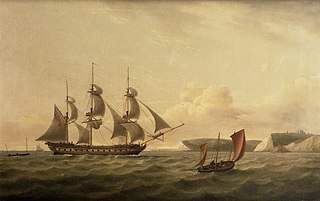
HMS Hussar was a 38-gun fifth-rate Amazon-class frigate of the Royal Navy. Launched at the end of 1799, the entirety of the frigate's career was spent serving in the English Channel and off the coast of Spain. Hussar primarily served as a convoy escort and cruiser, in which occupation the frigate took several prizes, including the French privateer Le General Bessieres. Towards the end of 1803 Hussar was sent to serve in Sir Edward Pellew's Ferrol squadron. On 8 February 1804 Hussar was returning to England with dispatches when the ship was wrecked off the coast of Île de Sein. The crew attempted to sail for home in a fleet of commandeered boats, but the majority were forced to go into Brest to avoid sinking in bad weather, where they were made prisoners of war.

The Perseverance-class frigate was a 36-gun, later 42-gun, 18-pounder fifth-rate frigate class of twelve ships of the Royal Navy, constructed in two batches. Designed by Surveyor of the Navy Sir Edward Hunt the first iteration, consisting of four ships, was constructed as a rival to the similar Flora-class frigate. Strongly built ships, the Perseverance class provided favourable gunnery characteristics and was highly manoeuvrable, but bought these traits with a loss of speed. The name ship of the class, Perseverance, was ordered in 1779 and participated in the American Revolutionary War, but her three sister ships were constructed too late to take part. The class continued in service after the war, but soon became outdated.

The Narcissus-class frigate was a 32-gun, 18-pounder fifth-rate frigate class of five ships of the Royal Navy. Designed by Surveyor of the Navy Sir John Henslow, the class was created to make use of shipyards that could not construct larger frigates. They were similar in design to the preceding 32-gun frigate class, the Amphion class, but were slightly shorter. Two ships were initially constructed, with a later batch of three being ordered in response to an Admiralty request for the resumption of production of proven frigate designs. The final two ships of the class were cancelled when the shipyard they were being constructed at went bankrupt. Unlike her sister ships, the name ship of the class Narcissus was armed with experimental short 24 pounders rather than 18 pounders.
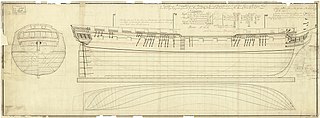
Aigle-class frigates were 36-gun sailing frigates of the fifth rate designed by Surveyor of the Navy, Sir John Henslow for the Royal Navy. Only two were built: HMS Aigle and HMS Resistance. Aigle was ordered first on 15 September 1798 but a 16-month delay during her construction meant that Resistance was completed and launched first on 29 April 1801.
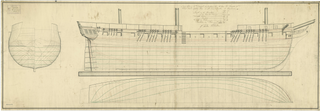
HMS Hebrus was a 36-gun Scamander-class frigate of the Royal Navy. Constructed in response to the start of the War of 1812, Hebrus was commissioned in October 1813 under Captain Edmund Palmer. Serving initially in the English Channel, on 27 March 1814 the frigate fought at the Battle of Jobourg during which she captured the French 40-gun frigate Étoile in a single-ship action. Hebrus was subsequently transferred to serve in North America. She participated in the expedition up the Patuxent River in August which resulted in the destruction of the Chesapeake Bay Flotilla, and Palmer was also present at the Battle of Bladensburg.

HMS Blanche was a 36-gun fifth-rate Apollo-class frigate of the Royal Navy. She was commissioned in 1800 by Captain Graham Hamond, under whom on 2 April 1801 Blanche fought as part of the frigate reserve at the Battle of Copenhagen. She spent the remainder of the French Revolutionary Wars serving in the English Channel. When the Napoleonic Wars began in 1803 Blanche was sent to serve in the West Indies under the command of Captain Zachary Mudge. There the frigate participated in the Blockade of Saint-Domingue and an unsuccessful invasion of Curacao, capturing upwards of twenty-four vessels.

HMS Stag was a 36-gun fifth-rate Apollo-class frigate of the Royal Navy. Commanded by Captain Phipps Hornby for almost her entire career, Stag began her service in the English Channel, capturing two ships in 1813. Mid-way through the year the frigate was sent to join the Cape of Good Hope Station, where she stayed until November 1814. At the Cape Stag formed part of the search for the wreck of the merchant ship William Pitt in Algoa Bay, and then spent time surveying the Bird Islands, of which one was subsequently named after the ship. After returning from the Cape, Stag was laid up at Plymouth Dockyard. She was moved to Sheerness Dockyard in 1821, where after an aborted refit the frigate was broken up.

HMS Regulus was a 44-gun fifth-rate Roebuck-class ship of the Royal Navy launched in 1785. Not commissioned until 1793 for the French Revolutionary Wars, Regulus served predominantly as a troop ship. After initial service in the English Channel she moved to the Jamaica Station where she saw action around Hispaniola and Puerto Rico. Returned to Britain in 1799, the ship served during the Egypt Campaign in 1801 and was present at the Battle of Abukir.

















